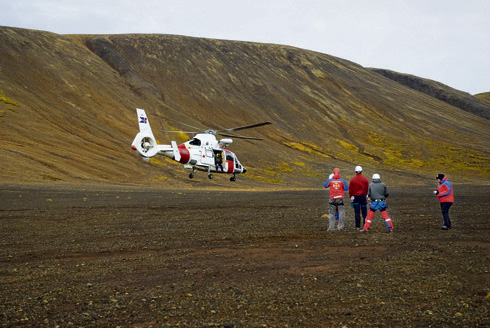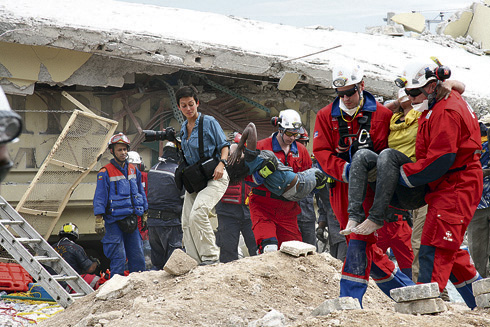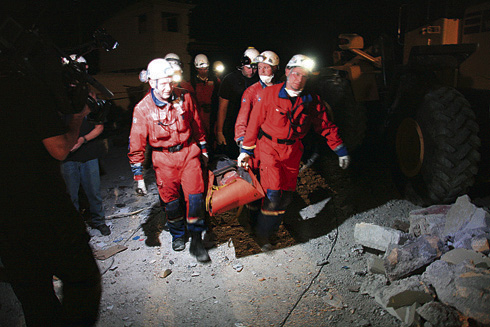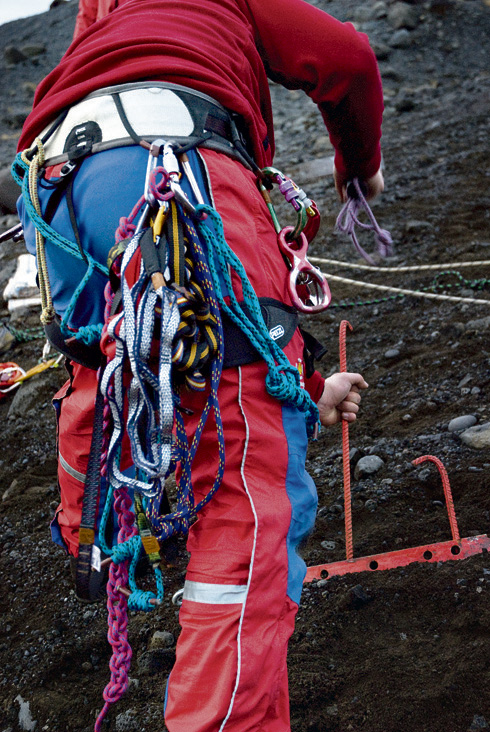It’s 5:45am, Saturday morning. The aftermath of a night of partying is apparent while passing the streets of downtown Reykjavík. A young man who seems to have lost his coat struggles to cross the street, finds his way to the nearest doorway and proceeds to vomit. We observe this, and we move on without offering our help. We are on a mission: to cover a day in the life of Rescue Team Hafnarfjörður, one of 99 rescue teams currently operating in Iceland.
The big day out
We arrive at Rescue Team Hafnarfjörður’s headquarters at six in the morning. A handful of rescue workers are buzzing about. Coffee is drunk, teeth are brushed and warm, sensible clothing is put on. Large backpacks are filled with mountain rescue equipment: compasses, first aid kits and the like. One rescuer is still fast asleep on the floor, wrapped tight in a sleeping bag.
It is no ordinary day, at least not for this team of rescuers. This sort of training day is only done every other year—rescue teams from around the country participate in an entire day of rehearsing and teambuilding. At eight in the morning, the organisers start handing out tasks to the different teams over radio, telling them where to go and what to do when they get there. The tasks are all staged takes on situations that might confront the squads at any point; potential disasters that victims need to be rescued from. And when the rescue is done, they get assigned new one.
There is not necessarily any time to rest or gather one’s thoughts during a disaster. This was demonstrated repeatedly throughout the day.
We sit, waiting for our instructions, pining for coffee. Out of the blue, a call comes. The mountain rescue group – four young men named Ásgeir, Bergur, Kolbeinn and Tómas – is off to Grindavík for the day’s first rescue mission. They scramble into an enormous jeep with an ATV strapped to the back. Before approaching the site, the group pulls over to gear up. Bergur hands over some helmets to put on if we happen to be under a cliff or if a helicopter should hover above. The group sports their climbing gear, with all the gadgets it involves. To get pumped, they play some very loud music over the car stereo. They are having a blast, it appears.
Mistakes you can make
Their first mission is to rescue three kids who have been climbing a cliff near the ocean. One fell and is injured; the other two are stuck on a ledge, too afraid to move. They need to rescue those prop-kids, stat!
 We share conversation on our way to the scene. “All real calls are ‘fun’ so to speak, but the most important thing is to get the people out safe,” Ásgeir comments as we near our destination.
We share conversation on our way to the scene. “All real calls are ‘fun’ so to speak, but the most important thing is to get the people out safe,” Ásgeir comments as we near our destination.
The most common type of call they get is to assist tourists or travellers, they tell me. Some fail to plan their route, to tell anyone where they’re headed and when they will return. Such lack of foresight generally causes trouble for the rescue squads, as the travellers’ friends will inevitably get worried and call for help when they don’t hear from them after a while.
There are those who to think it’s a good idea to cross rivers or travel off-road in the highlands in their small rental cars, getting stuck in the process.
And then there are a few crazies every now and again, folks who think they can simply cross glaciers in their sneakers and hoodies, no problem.
Many travellers simply underestimate the weather. “The first mistake is not to check the weather and to be ill equipped for Icelandic conditions. The second mistake is to travel without any experience with this kind of terrain. It’s usually just really silly mistakes that people make,” Ásgeir explains.
On average there are 3–4 callouts per day, all year round. Besides helping out travellers, the rescue teams get numerous calls to search for missing persons, old people with Alzheimer’s for instance. Of course they get very busy during storms, avalanches, floods and earthquakes – sometimes they’ll even cross the globe to administer their expertise. You can read about one of those trips in the accompanying sidebar.
All work and no pay
Everyone working in the rescue squad is a volunteer.
Each team is self sufficient; each team raises funds, buys its equipment and maintains it on their own accord. Equipment such as jeeps, snowmobiles and boats. They raise the bulk of their funds through selling fireworks during the days before New Year’s Eve. They also sell Christmas trees and provide security at large events. In addition they receive some funding from the ICE-SAR headquarters – they mainly get their money from the slot machines found in Icelandic bars and kiosks.
You would think that people would enjoy something in return, what with all that time and effort they put in. But the rescuers just shrug at the notion – according to them, the question of payment is actually not an issue at all. This is tradition. Kolbeinn explains that for most people it’s simply a hobby where they get the opportunity to travel, get educated and have access to some cool equipment. It’s also a chance to give back to one’s community.
The system seems to work well, as the members have been able to keep up with global standards of professionalism. One should also note that Iceland is a large island, with a scattered population and vast rural areas. The cost of having all 3.000 rescuers on payroll would be enormous, way too much for such a small population. Yet when disaster strikes, such a large number of trained rescuers is surely needed.
You might also note that Iceland has never had any local armed forces.
Time for some action
The sun rises as we arrive at our first disaster site. We are joined there by a rescue team from Akureyri. Soon, those present gather in a circle to discuss the action plan. Around fifteen rescue workers will be cooperating on the task. Kolbeinn explains that everyone on site has a specific role. Mountains are on one side, the roaring ocean on the other, and the three faux victims are inbetween. It’s quite the pickle.
There is a lot of assessing of the area, fastening and securing of ropes and communicating on walkie talkies. They drill holes in rocks to build anchors to tie the lines, they lay out rubber mats over the edge so the lines won’t snap. Before you know it, Bergur is lowered down, reaches the eager kids and administers them some much needed pretend-first aid.
The scene resembles a construction site, with its complicated network of ropes and folks attached to them. There is some muttering about the weather being too good to train in. Not realistic enough. Not enough of a challenge.
After about an hour, the injured kid is pulled up over the edge on a stretcher. Soon thereafter the other two follow, accompanied by a rescue worker. Mission: accomplished!
Bergur, looking anxious to move on to the next rescue, thinks it went well. “They were pulling us up a little too fast, but in total we got the kids up safely and in reasonable time,” he tells me before skirting off.
There’s more to it
ICE-SAR is more than just a search and rescue organisation. Rescue teams, accident prevention squads and youth divisions all operate under the umbrella.
The Accident Prevention Department is an increasingly important part of ICE-SAR. There are around 40 active groups in the organisation, groups whose main goal is to prevent accidents in their community. Tasks involve safety education for children and the elderly by giving lectures or distributing educational materials. Then there is traffic, bicycle and mountaineering safety. Ironically, they also try and educate the masses on firework safety in the days leading up to New Year’s Eve.
There are fifty youth groups working within ICE-SAR that will provide essential fodder for future rescue teams. Teenagers between the ages of 14–18 learn and practice first aid, mountaineering and search and rescue. ICE-SAR often gets its members from the Icelandic Boy and Girl Scout Association. When the youngsters turn 18 they’ll sometimes want to join a rescue team and start heavier training. If you want to go on callouts, you’ll have to complete 1–2 years of solid training.
To the rescue!
For Rescue Team Hafnarfjörður, there is no rest after their first task is complete. The next one is just a couple minutes drive away and the destination is a valley between high mountains. A fictional bird hunter fell while climbing the mountain in search of some tasty ptarmigan, breaking a leg in the process. A doll representing our hunter friend has been placed on the highest point and the idea is for rescue teams and the Coast Guard helicopter pilots’ to practice some co-operation.
Again, there is the gathering in a circle at the site. One group will scale the mountain by foot; the other will go by helicopter. Tómas marks out a landing spot in the valley with a smoke bomb just as the helicopter appears in the distance. It’s all kind of like an action movie. Our friends Ásgeir, Bergur, Kolbeinn and Tómas part; some start walking towards the mountain with determined steps, others ducking into a helicopter. To the rescue!
Search and Rescue in Haiti
Icelandic rescuers first to arrive after earthquake hits
 Following the massive earthquake in Haiti on January 12, the Icelandic Search and Rescue (ICE-SAR) team was the first international team to arrive at the scene. The team landed in the country’s capital Port-au-Prince just 24 hours after the earthquake hit. Iceland’s fast response was noted all over the world.
Following the massive earthquake in Haiti on January 12, the Icelandic Search and Rescue (ICE-SAR) team was the first international team to arrive at the scene. The team landed in the country’s capital Port-au-Prince just 24 hours after the earthquake hit. Iceland’s fast response was noted all over the world.
“What usually delays the deployment of rescue teams is bureaucracy, i.e. the time it takes the government to decide to send aid,” says ICE-SAR PR-officer Ólöf Snæhólm Baldursdóttir. “The short chain of command in Iceland and the effective work of public officials made the fast response possible.”
Just after the news of the earthquake Minister for Foreign Affairs, Össur Skarphéðinsson, was up all night with his staff to smooth things along. While awaiting response from officials, the rescue team was at an alert status and spent the night preparing for the mission at the ICE-SAR headquarters. Icelandair had a plane ready to transport the team and the team’s equipment is ready at Keflavík airport at all times.
Funds for the transportation costs were secured from the government very early on. Pure costs were lower than could be expected, as members of the rescue team all work on a volunteer basis, and ICE-SAR teams buy and own all their equipment. “It has taken years of meticulous planning and training to organise this and countless hours of fundraising for the equipment,” says Ólöf.
The team sent to Haiti consisted of 35 people. It operates as an international special unit within ICE-SAR and is specialised in rescue missions in ruins. It is also a registered team under the UN umbrella.
Taking charge and rescuing lives
The Icelandic team took control of the international search and rescue (SAR) camp upon arrival in Haiti. They set up a base camp and were involved in the coordination of activities for all the international SAR teams. “Taking charge of the camp was a logical thing to do after being the first to arrive,” Ólöf explains.
During their first rescue mission in Port-au-Prince the ICE-SAR team rescued three women from the ruins of a four-story building. They were also the first international aid to arrive in the town of Léogane, which is situated near the earthquakes epicentre. There they found no survivors in the rubble, but the team provided medical assistance to a large number of injured people in the city. All things considered, the members of the Icelandic team remained in good condition throughout their stay.
“There are a lot of difficulties facing rescue teams that arrive in a disaster area. The overall situation, the horrible consequences of the earthquake on top of physically and mentally challenging work from sunrise to sunset accompanied by only 4–6 hour sleep every night is the most difficult thing.”
Although news coverage from Haiti portrayed the safety situation in the country as extremely critical after the earthquake, the ICE-SAR team reported that they were received with nothing but gratitude and warmth by the local population. “The team has an extensive safety plan, and they usually worked with armed guards from the UN Peace Corps,” says Ólöf.
The ICE-SAR team left Haiti on January 20th, about a week after their arrival. It is a rule of thumb that urban SAR teams cease operations 48 hours after the last rescue of a survivor. The Icelandic camp with part of their equipment was left behind since it was used as a nerve centre for all international search and rescue teams. “There was not much more for the ICE-SAR team to do and we will not send more people to Haiti. Now other organisations will deliver aid to those who survived.”

—
SIDEBAR: Travelling Tips
Be prepared
Be prepared. Read information about the area you are visiting, and Iceland in general, so you know what to expect. Believe what you read! Too many travellers get into trouble because they fail to acknowledge how harsh the environment can be. Have a travel plan and let someone in on it. Info on safe travel in Iceland can be found on www.safetravel.is.
Be equipped
Bring all the necessary equipment, such as a compass, GPS navigator, map, some means of communication (satellite phone/spot emergency button) and know how to use it. Pack clothes for all weather conditions and remember that it can snow in Iceland in the summertime. Bring plenty of food, including an emergency stash.
Be smart
Remember that the roads in the highlands are only made for 4×4 jeeps. If you get into trouble while driving, stay in the car and call 112 for assistance.
Keep in mind…
…that river crossings keep changing in Iceland. On warm summer days the flow increases as the day progresses. Also, heavy rain often causes rivers to swell which can make them impossible to cross even with large and well equipped vehicles. Underestimating water volume in rivers has resulted in deaths.
Better to be safe than sorry
As previously stated, numerous travellers on this island tend not to recognise how harsh the environment is. For all travellers who realise the dangers inherent in Icelandic nature and wish to come out alive, ICE-SAR has a travellers reporting service. People who plan to wander in the highlands and wilderness can register at the ICE-SAR office in Reykjavík. Basically, if you don’t report back at a given time when you’ve finished your trip an investigation will start and a search will be launched.
Better to be safe than sorry, right?
—
SIDEBAR: The History of ICE-SAR
 The rescue teams of Iceland all coexist under the umbrella organisation ICE-SAR (Icelandic name: Landsbjörg), the Icelandic Association of Search and Rescue. The mission: to save lives and valuables and to prevent accidents.
The rescue teams of Iceland all coexist under the umbrella organisation ICE-SAR (Icelandic name: Landsbjörg), the Icelandic Association of Search and Rescue. The mission: to save lives and valuables and to prevent accidents.
ICE-SAR is part of a long tradition the origins of which date back to 1918, when the first rescue team was established in the Westmann Islands. It was started mainly because of frequent ship losses and deaths of fishermen. Today, all fishermen must participate in extensive sea survival training by law. Before they go out to sea for the first time, they attend the basic sea survival course at the Maritime Safety and Survival Training Centre, founded by ICE-SAR in 1985. Students learn how to use, among other things, life rafts, lifejackets, survival suits and flares. This has resulted in record lows of serious accidents at sea in recent years. For example, back in 1985 Iceland was losing twenty people at sea every year: today it’s down to two or three persons yearly. Last year was the first recorded one that absolutely no one died at sea.
Today there are around 3.000 active rescuers involved in the different rescue teams across the country. They are on standby for emergencies day and night all year round. In recent years there has been an increased specialisation within the rescue teams. Every team has members equipped for certain tasks: avalanche rescue, rescue at sea, first aid groups, search groups, search dog groups, urban search and rescue, diving groups, etc., etc.
More on ICE-SAR: www.landsbjorg.is
Buy subscriptions, t-shirts and more from our shop right here!















